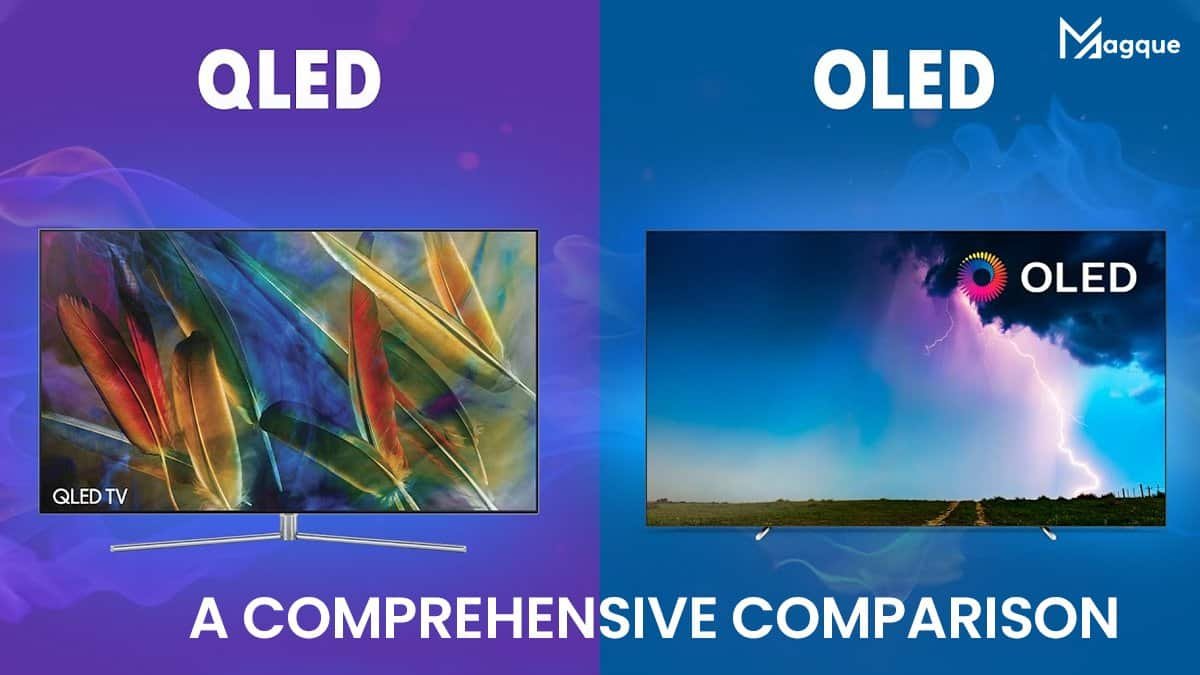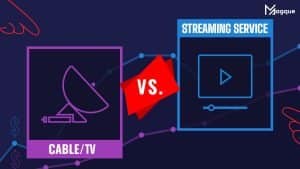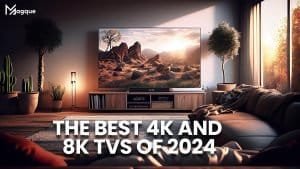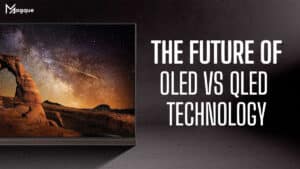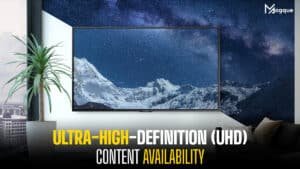The Great TV Battle: OLED vs QLED Showdown
Hey, TV enthusiasts! Ready to embark on a journey through the epic battle of display technologies? Today, we’re diving into the OLED vs QLED saga – a showdown shaking up the TV realm. So, grab your popcorn, settle into your comfiest spot, and explore the dazzling world where pixels and innovation collide!
The Luminescent Symphony of OLED
Let’s kick things off with OLED – the rockstar of the display universe. Imagine a TV that’s not just a screen but a canvas of individual, self-illuminating pixels. It’s like having millions of tiny artists, each responsible for creating a part of the visual masterpiece. OLED, or Organic Light-Emitting Diode, brings you true blacks, vibrant colours, and an almost surreal contrast level.
Picture this – you’re watching a midnight scene in a movie, and the black is so deep it feels like you’re peering into the abyss. That’s the OLED magic. The technology allows each pixel to emit light, resulting in unparalleled picture quality. It’s like upgrading from a basic sketch to a high-definition, 3D masterpiece – every detail pops, and every shade is a revelation.
QLED: The Quantum Leap in Display Brilliance
Now, let’s shift our gaze to QLED – the contender with quantum tricks up its sleeve. Quantum Dot technology is the superhero, enhancing your viewing experience with a spectrum of colours as vast as the universe. It’s like having a palette with an infinite range, where every hue is vibrant, every scene is lifelike, and the colours practically burst off the screen.
In the QLED realm, a layer of quantum dots works its magic, transforming light and colour into a symphony for your eyes. It’s like upgrading from a regular colour palette to one enriched with gold, giving you a visual richness that’s hard to match. The technology also tackles issues like colour fade, ensuring your TV stays as vibrant as the day you unboxed it.
The Contrast Chronicles: OLED’s True Black vs QLED’s Quantum Brilliance
One of the key battlegrounds in the OLED vs QLED saga is contrast – the superhero’s ability to distinguish between the darkest blacks and the brightest whites. With its pixel-perfect illumination, OLED achieves true black by turning off individual pixels. It’s like having a light switch for each pixel – when it’s off, it’s truly off.
On the QLED side, the Quantum Dot layer works with an LED backlight. While it can’t achieve the same true black as OLED, it compensates with incredible brightness. It’s like a cosmic dance of light and colour, where the deep blacks of OLED meet the dazzling brightness of QLED, creating a visual spectacle that caters to different tastes.
The Battle of Viewing Angles: OLED’s Versatility vs QLED’s Wider Reach
Have you ever had that annoying moment when you move a bit to the side, and suddenly, the colours on your TV lose their charm? OLED comes to the rescue with its wide viewing angles. Each pixel emits its light, ensuring consistent colours even if you’re watching from the edge of your couch. It’s like having front-row seats, no matter where you are in the room.
On the QLED front, the battle is no less intense. Thanks to technological advancements, QLED TVs have significantly improved their viewing angles. While not matching the versatility of OLED, QLED ensures that even if you’re not sitting dead centre, you’re still getting a premium visual experience. It’s like expanding the VIP section to accommodate everyone in the room.
Lifespan Showdown: OLED’s Gradual Evolution vs QLED’s Endurance Race
In the longevity arena, OLED and QLED take different paths. OLED’s organic compounds might experience gradual decay over time, leading to potential image retention. It’s like a painting evolving over the years – the changes are subtle, and the art matures. Manufacturers are implementing measures to mitigate this, but it’s a characteristic to remember.
On the QLED side, the Quantum Dot layer is in for the long haul. With no organic compounds to age, QLED TVs boast impressive durability. It’s like having a timeless masterpiece that stays vibrant, resisting the effects of time. If you’re in for the endurance race, QLED might be your reliable marathon runner.
The Price Tag Tango: OLED’s Elegance vs QLED’s Affordability
Now, let’s talk about the budget tango. With their cutting-edge technology, OLED TVs often come with a higher price tag. It’s like opting for a luxury car – you’re paying for the sleek design, top-tier performance, and that undeniable wow factor. If you’re looking for the crème de la crème and budget isn’t a hurdle, OLED might be your red-carpet choice.
Without emptying your wallet. QLED provides a sweet spot for those who crave high-quality visuals without significantly impacting the bank account.
The Future Glimpse: OLED and QLED Innovations
As we gaze into the future, both OLED and QLED are poised for further innovations. OLED technology is exploring ways to extend its lifespan and mitigate potential drawbacks, while QLED continuously pushes the boundaries of colour accuracy and brightness. It’s like witnessing the evolution of two TV dynasties, each vying for the throne of display supremacy.
Mini-LED and MicroLED: A new contender is emerging: Mini–LED and MicroLED technology. Both OLED and QLED are facing competition from this pixel-sized revolution. Mini-LED enhances backlighting precision, reducing blooming and improving contrast. MicroLED takes it even further, with each pixel emitting its light, similar to OLED. The future might witness an even fiercer battle for your living room.
Choosing Your Champion: A Personal Odyssey
So, which TV tech is your knight in shining armour – OLED or QLED? It ultimately boils down to your preferences and priorities. If you seek the deepest blacks and individual pixel control and are ready to invest in a premium visual experience, OLED might be your artistic muse. On the other hand, if you crave vibrant colours, impressive brightness, and affordability without compromising on quality, QLED could be your technological sidekick.
Magque’s Curation: Where Choices Meet Excellence
At Magque, we understand that the world of TV is a vast landscape with choices as diverse as the viewers themselves. That’s why we curate a selection that combines excellence, innovation, and the latest display technology. Whether you’re Team OLED or Team QLED, our goal is to provide you with a visual journey that aligns with your unique preferences.
In conclusion, the OLED vs QLED saga is a testament to the dynamism of display technology. Each technology brings its strengths to the table, creating a market where diversity is the key. So, pick your champion, set up your viewing arena, and let the battle of pixels unfold in your living room. Happy watching!
And be sure to explore Magque, your go-to source for the latest and most intriguing updates in the realms of informative tips & reviews!
FAQs
Q1. Why should I consider integrating educational apps into my child’s learning routine?
A. Educational apps offer a dynamic blend of fun and learning, engaging children in an interactive and practical educational experience.
Q2. How can I ensure that my child’s educational apps are age-appropriate?
A. Ensure age suitability by considering your child’s developmental stage, reviewing app content, and utilizing age ratings provided by app stores.
Q3. Should educational apps replace traditional learning methods or complement them?
A. Educational apps complement traditional methods, providing an additional interactive and engaging layer to enhance the learning experience.
Q4. What safety measures should I take to ensure my child’s secure use of educational apps?
A. Prioritize apps with robust privacy features, avoid those with in-app purchases, and regularly monitor your child’s app usage for a secure digital learning environment.
Q5. How do I balance my child’s screen time with educational apps and other offline activities?
A. Establish clear screen time limits, encourage breaks for physical activities, and foster diverse offline interests for a well-rounded and balanced learning approach.
Read Also This:- The Best 4K and 8K TVs of 2024

